Someone s Got Their Knee Stuck on Ruper Again
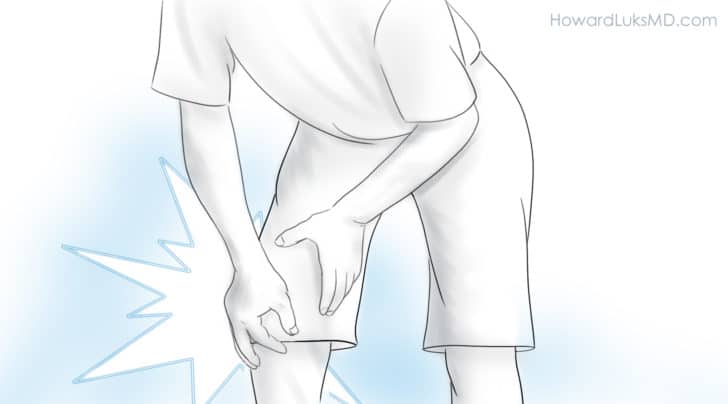
Your articulatio genus twists, you hear a popular, and now you have knee swelling and pain when trying to walk or with angle your knee. Maybe you were struck by another player and accept bruising, but no swelling. Are these astringent knee joint injuries? When should yous consider seeing a Sports Medicine Medico following a articulatio genus injury? Let'southward go over v things that trained professionals look for to determine if your knee joint injury is serious.
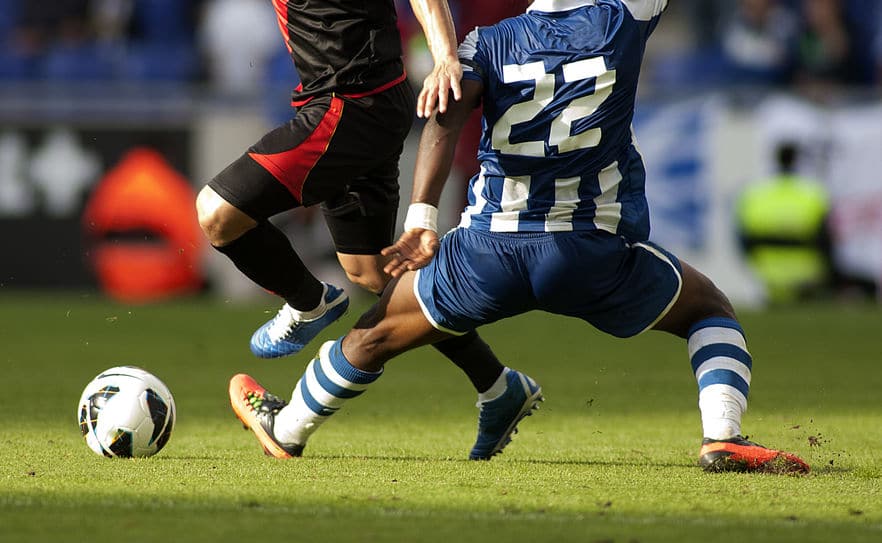
Every bit an active athlete or competitor, you know that astringent articulatio genus injuries are mutual. Both contact and not-contact knee injuries can be astringent. This postal service will comprehend five signs to expect for to help determine if you might have a astringent knee injury. In general, the most common and worrisome finding is immediate, meaning swelling.
Even though near of the injuries I see in the function turn out to exist mild, it is essential for you to know what the warning signs are to look for a potentially astringent knee injury.
Five signs of a potentially serious human knee injury:
i. Your Knee joint Is Bloated
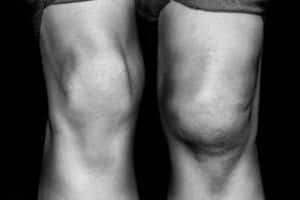 Swelling in the knee immediately or shortly after an injury is a common sign that indicates you may accept sustained a serious articulatio genus injury. In many cases, the swelling is due to blood. The bleeding will stop, but the swelling will remain. Blood in the articulation is called a hemarthrosis. Blood in the knee can cause a lot of pain due to inflammation. If nosotros suspect that you have blood in your human knee articulation, that often means that you lot sustained a severe injury. The haemorrhage is commonly due to something inside the articulatio genus tearing.
Swelling in the knee immediately or shortly after an injury is a common sign that indicates you may accept sustained a serious articulatio genus injury. In many cases, the swelling is due to blood. The bleeding will stop, but the swelling will remain. Blood in the articulation is called a hemarthrosis. Blood in the knee can cause a lot of pain due to inflammation. If nosotros suspect that you have blood in your human knee articulation, that often means that you lot sustained a severe injury. The haemorrhage is commonly due to something inside the articulatio genus tearing.
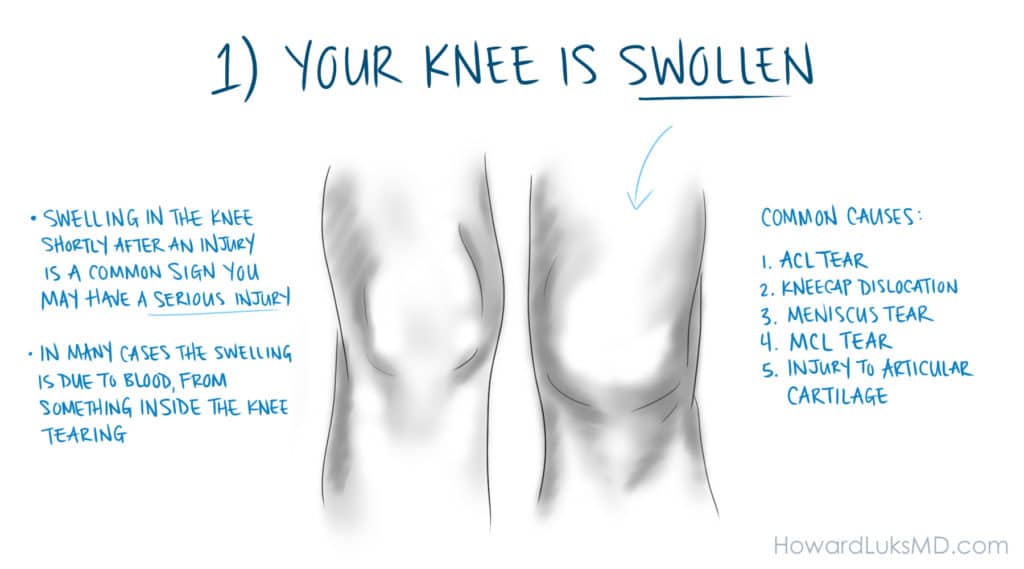
Common causes of swelling after a astringent genu injury include:
- A tear of the ACL
- Patella or kneecap dislocation
- A meniscus tear: specifically a Bucket-Handle Tear.
- An MCL tear
- Injury to the articular cartilage.
Over 70% of athletes with a swollen knee who felt a pop while running and pivoting will have an ACL tear or a patella dislocation. Patella (kneecap) dislocations are more common than yous think. All of you dread an ACL tear. But most of y'all are surprised when we see yous in the part and tell you that your kneecap dislocated. Most dislocated kneecaps will reduce spontaneously on the field. That means that the kneecap will go back into place on its own.
Patellar dislocations may hurt just as much as an ACL tear. Because patella dislocations are such a mutual sports injury nosotros wrote this post to go into far more item about them.
With whatever of the in a higher place issues, nearly of you volition find it very difficult to walk without severe knee pain. Crutches, icing, and top are beneficial in these cases. These knee joint injuries need to be evaluated for an X-ray. Fractures are rare, but they practice occur. Very few knee joint injuries will require a brace unless y'all want to employ it for comfort. The almost important reason for seeing a sports medicine physician after an injury that causes swelling is to look for these most common severe injuries.
Many of these astringent articulatio genus joint injuries should be evaluated sooner rather than after. The initial treatment will be a reliable examination to go far at a diagnosis, which will be followed with an MRI to confirm the diagnosis. Depending on what we remember y'all injured, we may consider rest, physical therapy, or surgery.
2. Your Knee Is "Locked" And You lot Can't Straighten It
If you had a genu injury and y'all are not able to fully straighten the leg, you might take a "locked knee joint." A locked knee is simply a knee that cannot fully straighten. There are unlike reasons a locked articulatio genus might occur. In some patients, swelling and inflammation can prevent you lot from fully straightening the genu. In others, a meniscus tear has flipped into the centre of the joint and is causing mechanical locking. You cannot straighten it with the meniscus in that position.
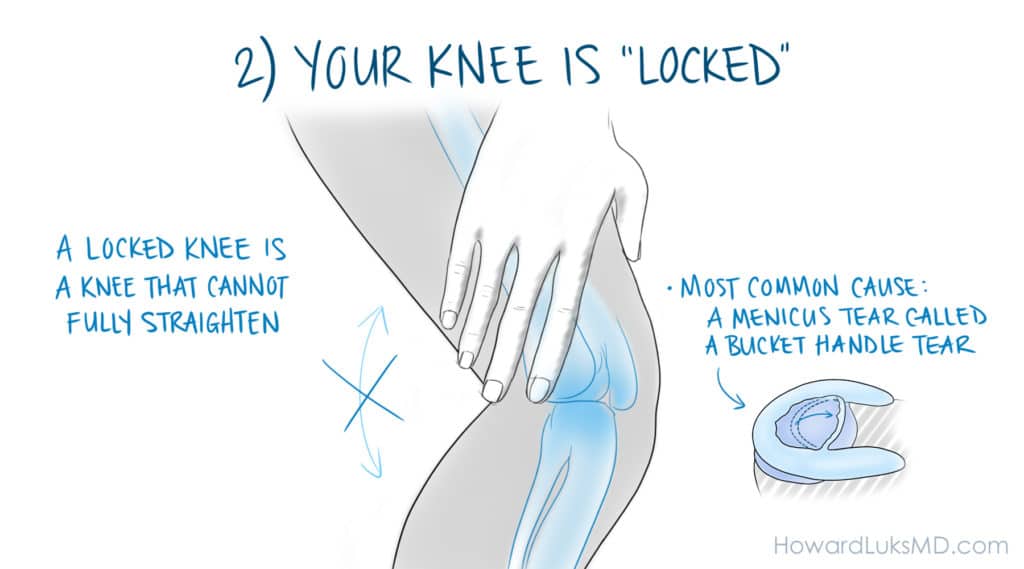
Many athletes who have a locked knee joint volition also find information technology very painful to bend the knee joint too. They may feel sharp knee pain when bending which can occur when these bucket handle meniscus tears move.
The most common crusade of a locked articulatio genus is a unique meniscus tear called a bucket handle tear. A bucket handle tear is considered a serious articulatio genus injury and volition crave surgery to fix or repair the tear. The reason these tears are serious is that a large piece of the meniscus tears flips over and becomes stuck in the eye of the knee articulation. You lot need that meniscus to protect the human knee. The vast majority of bucket-handle tears tin can be repaired. So the sooner we starting time the treatment process, the ameliorate the outcome might be after a meniscus repair.
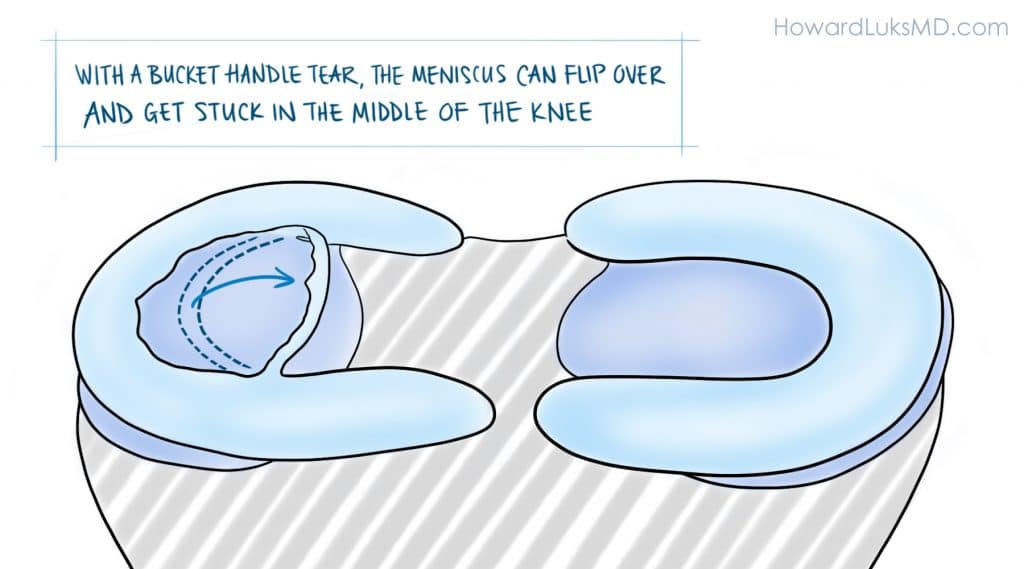
Although we talk over bucket handle tears here. Not all locked knees volition be found to have a bucket handle tear. In older athletes, a flap tear, or different types of meniscus tears typically occur. These types of tears are also essential to identify early on. Most bucket handle tears are repairable. The torn bucket handle should not be removed from the knee, if at all possible. These tears, which cause a locked knee, are oftentimes very large. If the slice is removed and non repaired, so you have a meaning gamble of developing osteoarthritis. These saucepan handle tears do not require emergency surgery, but they are urgent, and you should see a sports medicine medico if you experience similar something is preventing you from straightening your articulatio genus all the way.
Practice I Have A Serious KNEE injury??? five Things to Look Out For
three. Your Knee joint Feels Unstable, or You Felt a Popular
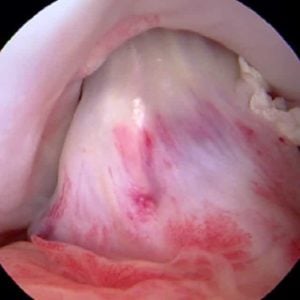
Most ACL tears and patella dislocations occur from a twisting, non-contact injury. A typical story is that you were turning or twisting hard, and you lot felt a popular. Equally I mentioned before, almost patella dislocations volition reduce or go back into their usual place on their own. Simply if your patella remains confused the knee will look strange.
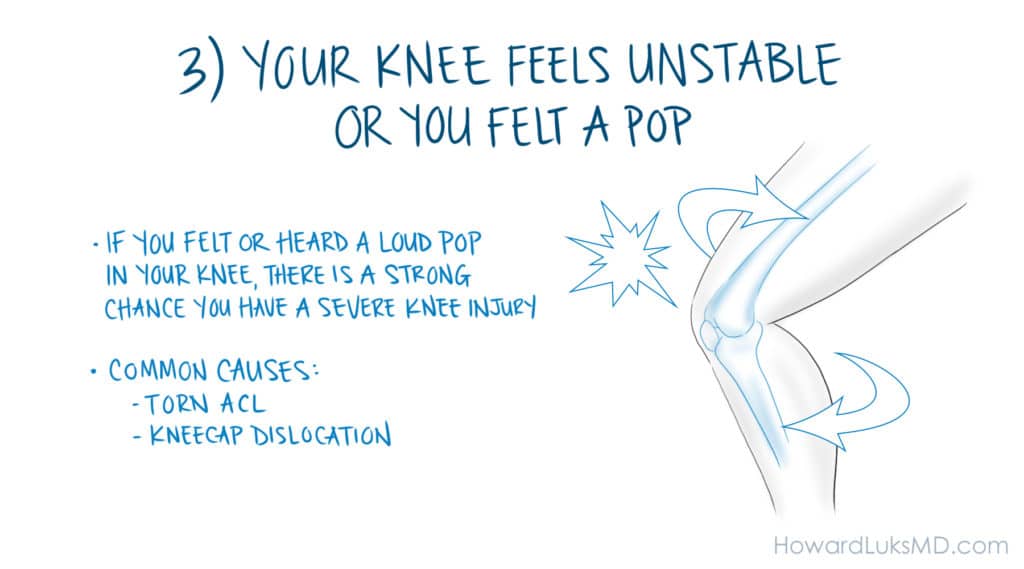
If you felt or heard a loud pop every bit you lot twisted or turned to avoid another player, so you may accept torn your ACL. Other causes of popping include a patella or kneecap dislocation. If you felt or heard a loud popular in your knee joint, and so there is a strong take chances that you have a severe knee injury. Well-nigh ACL injuries and patella dislocations are non-contact injuries. A running back turning to head upfield. A striker moving laterally to avoid the defense. These are familiar stories when we come across high schoolhouse and college athletes who accept torn their ACL.
This post dives further into the immediate direction of suspected ACL injuries.
Again, another prevalent astringent knee injury following a loud pop is a patella dislocation. They are more common than most people think. Everyone has heard of an ACL tear, but most are non enlightened that the patella or kneecap can dislocate. Many patella dislocations will spontaneously reduce or go back into place. That ways that the patella was only confused for a second or ii. Patients with a patella dislocation often require an MRI to see if y'all injured the cartilage on the patella when it dislocated. Surgery to repair the patella ligaments is unremarkably not necessary for a start dislocation. This mail provides more information near patella dislocations.
4. You Have Significant Weakness Trying To Straighten Your Genu
Severe weakness when trying to straighten the knee, fifty-fifty a few days afterwards the injury, could mean that you suffered a severe tendon injury. Common causes of weakness include patella dislocations, patella tendon tears, and quadriceps tendon tears. Patella tendon and quadriceps tendon tears are non mutual in youth or collegiate sports, but nosotros will encounter a few of these every year.
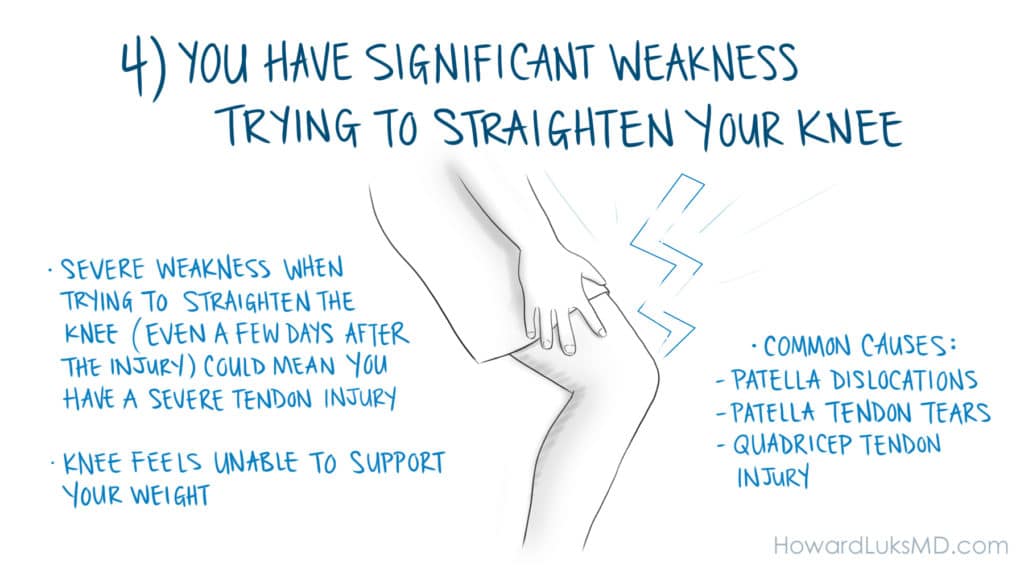
In older weekend warriors who are wondering why their knee is weak afterwards a serious injury, patella tendon and quadriceps tendon injuries are far more common. If you lot are over 35 and felt a loud pop in your articulatio genus while pushing off during tennis, or basketball and so y'all need to consider that you have seriously injured your patella or quadriceps tendon(s).
After an injury to i of these big, critically important tendons, you will find that the knee joint will feel unstable. You will call up that the genu is unable to support your weight without giving style. You should be promptly evaluated by a Sports Medicine dr. to make up one's mind the blazon of injury you had. Both quadriceps and patella tendon injuries crave surgery to repair these big essential tendons.
We discuss the management of patella tendon injuries in this mail. The direction of quadriceps tendon tears is very similar.
Patella dislocations occur generally in younger athletes. Most patella dislocations happen when the knee is aptitude, the athlete is twisting, then they are struck on the inner side of the knee. The patella will usually snap back into identify, but the damage is done. Any suspected patellar dislocation should be evaluated by a sports medicine physician since patella dislocations tin can cause injuries to the cartilage or the ligaments which hold the patella in place.
5. Y'all Have Pregnant Difficulty Walking
Of class, many knee injuries make it painful and hard to walk. For people with severe knee injuries, it is unremarkably very hard if not impossible to walk. You will oft demand to be helped off the field and require crutches. Anyone who is placed on crutches should be considered to have a serious knee injury until an Orthopedic Surgeon evaluates you. In many of these cases, an urgent X-ray is useful to rule out a fracture if the athlete cannot put any weight on the knee.
Take-Home Message: What to look for if you are worried that you lot might have a serious knee injury.
- Your knee is swollen
- You lot felt a pop
- Your knee is locked and will not straighten
- You take a significant weakness when trying to straighten the genu.
- You have persistent, significant difficulty walking or putting weight on your leg.
Human knee injuries are common beyond all sports. Most articulatio genus injuries are mild, and the athlete tin can expect to render to play relatively soon. Identifying the serious or severe knee injuries and acting chop-chop tin can make all the difference when it comes to getting you back in the game and minimizing your run a risk of farther damage.
Source: https://www.howardluksmd.com/signs-knee-injury-serious/
0 Response to "Someone s Got Their Knee Stuck on Ruper Again"
Post a Comment